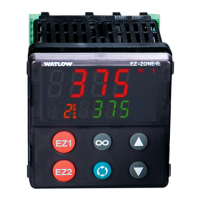Watlow EZ-ZONE
®
PMI Controller • 184 • Chapter 9 Features
at the normal set point, using the new parameters.
Select a set point for the tune with Autotune Set Point. The Autotune Set Point is expressed
as a percent of the Set Point.
If you need to adjust the tuning procedure's aggressiveness, use Autotune Aggressiveness
tagr (Setup Page, Loop Menu). Select Under Damped Undr to bring the process value to
the set point quickly. Select over damped ovEr to bring the process value to the set point
with minimal overshoot. Select critical damped Crit to balance a rapid response with mini-
mal overshoot.
Manual Tuning
In some applications, the autotune process may not provide PID parameters for the process
characteristics you desire. If that is the case, you may want to tune the controller manually.
1. Apply power to the controller and establish a set point typically used in your process.
2. Go to the Operations Page, Loop Menu, and set Heat Proportional Band h.pb and/or Cool
Proportional Band C.pb to 5. Set Time Integral ti to 0. Set Time Derivative td to 0.
3. When the system stabilizes, watch the process value. If it uctuates, increase the Heat
Proportional Band or Cool Proportional Band value in 3 to 5° increments until it stabilizes,
allowing time for the system to settle between adjustments.
4. When the process has stabilized, watch Heat Power h.pr or Cool Power C.pr (Opera-
tions Page, Monitor Menu). It should be stable ±2%. At this point, the process temperature
should also be stable, but it will have stabilized before reaching the set point. The differ-
ence between the set point and actual process value can be eliminated with Integral.
5. Start with an Integral value of 6,000 and allow 10 minutes for the process temperature to
reach the set point. If it has not, reduce the setting by half and wait another 10 minutes.
Continue reducing the setting by half every 10 minutes until the process value equals the
set point. If the process becomes unstable, the Integral value is too small. Increase the
value until the process stabilizes.
6. Increase Derivative to 0.1. Then increase the set point by 11° to 17°C. Monitor the sys-
tem’s approach to the set point. If the process value overshoots the set point, increase
Derivative to 0.2. Increase the set point by 11° to 17°C and watch the approach to the
new set point. If you increase Derivative too much, the approach to the set point will
be very sluggish. Repeat as necessary until the system rises to the new set point without
overshoot or sluggishness.
For additional information about autotune and PID control, see related features in this chap-
ter.
Autotuning with TRU-TUNE+
®
The TRU-TUNE+ adaptive algorithm will optimize the controller's PID values to improve con-
trol of dynamic processes. TRU-TUNE+ monitors the Process Value and adjusts the control pa-
rameters automatically to keep your process at set point during set point and load changes.
When the controller is in the adaptive control mode, it determines the appropriate output
signal and, over time, adjusts control parameters to optimize responsiveness and stability.
The TRU-TUNE+
feature does not function for on-off control.
The preferred and quickest method for tuning a loop is to establish initial control settings
and continue with the adaptive mode to ne tune the settings. Setting a controller's control
mode to tune starts this two-step tuning process. (See Autotuning in this chapter.) This pre-
dictive tune determines initial, rough settings for the PID parameters. Then the loop auto-
matically switches to the adaptive mode which ne tunes the PID parameters.

